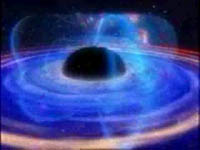|
|
X-Ray Sources Near and Far
X-rays are produced by a variety of processes in the universe. Some X-ray sources are relatively nearby like the Sun, but most are distant like black holes, pulsars, and neutron stars. Highlighted in these two videos, we see two contrasting sources of X-rays: black body radiation in the solar corona and material accretion in the Cygnus X-1 star system.
Near: The Sun

|
In this movie clip we see X-ray images of the Sun compared to an optical image of the sun. The X-ray Sun is clearly more dynamic than the nearly uniform orange Sun we are used to seeing.
Click on image to view QuickTime video. (5.9 MB)
Description
|
In this movie clip we see X-ray images of the Sun compared to an optical image of the sun. The X-ray Sun is clearly more dynamic than the nearly uniform orange Sun we are used to seeing.
The Sun's X-rays are created in the solar corona, the hot sea of gas surrounding the Sun, where they are emitted by hot gas and by solar flares. Both types of activity are fueled by strong magnetic interactions on the surface of the sun. In the case of solar flares, magnetic energy is released in the form of a violent burst of light and particles. In the case of hot coronal gas, areas of magnetic activity heat the gas in clumps, creating the hot and cool spots that we see in portions of the video.
These coronal hot spots give off X-rays in the form of black body radiation. A black body is an object that is hot and radiates some of its energy away in the form of different types of light. The type of light, or electromagnetic radiation, emitted by the object depends on how hot it is. In this case, the solar Corona is over a million Kelvin, which means it gives off very energetic forms of electromagnetic radiation like X-rays.
Far: Cygnus X-1

|
X-rays are created when the black hole pulls in material from it's companion star. The video clip displays this process, called accretion, which creates a large disk of hot gas around the black hole.
Click on image to view QuickTime video. (11.4 MB)
Description
|
Cygnus X-1 is an X-ray binary star system that consists of a blue supergiant star orbiting a black hole. In this case, the X-rays are created when the black hole pulls in material from it's companion star. The video clip displays this process, called accretion, which creates a large disk of hot gas around the black hole. As this material slips closer to the black hole, it loses a large quantity of gravitational potential energy which goes into heating the gas molecules around the black hole. These molecules then emit X-rays just like the solar corona.
Cygnus X-1 is a variable source. Its X-ray emissions don't follow a detectable pattern, or period, of brightness and darkness. Scientists suspect this is because of variations in the rate of accretion. Sometimes the gas that falls into the blach hole comes in larger clumps and bubbles like in the video clip, causing the X-rays to appear brighter here on Earth. At other times, less material is pulled in, causing drops in the brightness.
These clips are taken from the
"High Energy Groovie Movie," a tour of
the X-ray sky with lyrics from the
AstroCappella
song
High Energy Groove. The movie web site contains a high
resolution version of the entire movie, and classroom activities for each of
the topics in the movie.
|
